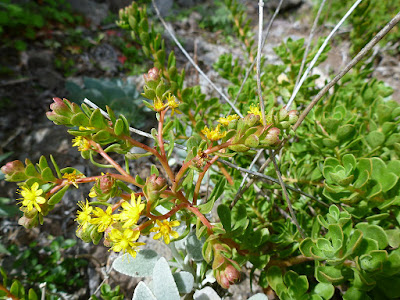Aichryson laxum is endemic to the Canary Islands, where it grows at an altitude of more than 1000 meters above sea level. It grows on wet cliffs in rock crevices and shady slopes and extra-humid places in laurel and pine forests. It is also encountered on damp, shady town walls...
Aichryson laxum also called as Tree of Love, Aeonium laxum, Aichryson dichotomum, Aichryson dichotomum var. hamiltonii, Aichryson laxum var. latipetalum, Aichryson laxum f. subglabrum, Sedum dichotomum, Sempervivum annuum, Sempervivum dichotomum, Sempervivum laxum, is a species of the genus Aichryson. This species was described by David Bramwell in 1968.
IDENTIFY AICHRYSON LAXUM
Aichryson laxum is endemic to the Canary Islands, where it grows at an altitude of more than 1000 meters above sea level. It grows on wet cliffs in rock crevices and shady slopes and extra-humid places in laurel and pine forests. It is also encountered on damp, shady town walls.
It is a succulent plant which is one of the most attractive species of the genus Aichryson, which rarely grows more than 30 cm in height with erect stems with numerous thin branches. The leaves are large, shaped like a spoon, dark green in color. They are assembled into sockets at the ends of branches. Petioles short. The color of the leaves depends on the light. In the bright sun they become brownish-green or khaki.
Tree of Love blooms in spring and lasts up to six months. After flowering, the plant may die. The pale yellow flowers with 13-6 mm in diameter are collected in the inflorescence, which appear from the center of the rosette of leaves.
AICHRYSON LAXUM CARE AND CULTURE
Cultural information should only be used as a guide, and should be to be adapted to suit you. Your physical location; where you grow your plants, how much time you have to devote to their care, and many other factors, will need to be taken into account. Only then can you decide on the cultural methods that best suit you and your plants.
Light:
Aichryson laxum needs a bright light with a certain amount of direct sunlight. In low light, this succulent stretches out and looks frail. If it loses too many leaves, the cause may be the effect of too dry hot air and a scorching sun. It is necessary to transfer the plant to a more suitable place.
Temperature:
This species grows well in a wide range of temperatures. At room temperature it will grow throughout the year. But in winter it is better to arrange the plant for a short period of rest and transfer it to a less lit and cooler place where the temperature drops below 13 ° C. The minimum temperature that this species can tolerate is 2 ° C.
Substrate, growing media and repotting:
Aichryson laxum are usually put in a standard soil mixture. Since this plant has a small root system, it does not need large pots. The adult plant grows well in pots with a diameter of 10-13 cm. In spring, if necessary, a plant that did not die after flowering is transplanted into the pot a larger size. When grown in the garden, this succulent is planted in sandy, loamy or clayey, well drained, slightly acidic soil with a pH of about 6.1-6.5.
Watering:
During the period of active growth, the plant should be watered sparingly, the soil mixture should be well saturated with water during irrigation. Between waterings the soil should dry out to half its depth. During the rest period, watering is reduced, not allowing, however, complete drying of the soil.
Fertilizer:
If Aichryson laxum has a rest period in winter, then it is necessary to feed the plant only during active growth, introducing a standard liquid fertilizer every two weeks. If there is no rest period, the fertilizer can be given throughout the year. When growing in the garden, two or three additional fertilization with a balanced fertilizer during the entire growing season are sufficient.
Reproduction:
The plant is easily propagated by apical cuttings 8-10 cm long, which are cut in spring or summer. From the cuttings you need to remove the lower leaves and plant it in a slightly moistened soil mixture consisting of equal parts of peat and coarse sand or perlite. Cuttings should be put in a bright place and gently poured, so that the soil does not dry out. Rooting occurs within three or four weeks. When the cuttings take root, they are transplanted into pots with a diameter of 8 cm into a standard soil mixture and are looked after as adults. In addition, after flowering, numerous seeds of the plant themselves are scattered and easily planted.

















COMMENTS